Posted by: site admin @ 5:31 pm
𝓛𝓔𝓢𝓢𝓞𝓝 4118 Mon 11 Oct 2021
Mindful
Swimmer Lavender Awakened CMJC 
 Pepper
Pepper  Cucumber
Cucumber  Carrots
Carrots  Beans in Pots. Fruit
Beans in Pots. Fruit  Bearing Trees
Bearing Trees  all over the world
all over the world  and in Space.
and in Space.  Happy
Happy  Life to Attain Eternal Bliss as Final Goal.-
Life to Attain Eternal Bliss as Final Goal.- Online Positive Universal Prabuddha Intellectuals Convention.
Online Positive Universal Prabuddha Intellectuals Convention.Wake up at 03:45 AM
After Bath Practice Patanjali Yogic Meditation From 04:00 AM to 05:00 AM at
𝙆𝙪𝙨𝙝𝙞𝙣𝙖𝙧𝙖 𝙉𝙄𝘽𝘽Ā𝙉𝘼 𝘽𝙃𝙐𝙈𝙄 𝙋𝙖𝙜𝙤𝙙𝙖
18𝙛𝙩 𝘿𝙞𝙖. 𝙖 3𝘿 360 𝙙𝙚𝙜𝙧𝙚𝙚 𝙘𝙞𝙧𝙘𝙪𝙡𝙖𝙧 𝙋𝙖𝙜𝙤𝙙𝙖 𝙖𝙩
𝙒𝙝𝙞𝙩𝙚 𝙃𝙤𝙢𝙚,
668 5𝙩𝙝 𝘼 𝙈𝙖𝙞𝙣 𝙍𝙤𝙖𝙙,
8𝙩𝙝 𝘾𝙧𝙤𝙨𝙨, 𝙃𝘼𝙇 𝙄𝙄𝙄 𝙎𝙩𝙖𝙜𝙚,
𝙋𝙪𝙣𝙞𝙮𝙖 𝘽𝙃𝙐𝙈𝙄 𝘽𝙚𝙣𝙜𝙖𝙡𝙪𝙧𝙪,
𝙈𝙖𝙜𝙖𝙙𝙝𝙞 𝙆𝙖𝙧𝙣𝙖𝙩𝙖𝙠𝙖,
𝙋𝙧𝙖𝙗𝙪𝙙𝙙𝙝𝙖 𝘽𝙝𝙖𝙧𝙖𝙩 𝙄𝙣𝙩𝙚𝙧𝙣𝙖𝙩𝙞𝙤𝙣𝙖𝙡

𝙗𝙪𝙙𝙙𝙝𝙖𝙨𝙖𝙞𝙙2𝙪𝙨@𝙜𝙢𝙖𝙞𝙡.𝙘𝙤𝙢
𝙟𝙘𝙨4𝙚𝙫𝙚𝙧@𝙤𝙪𝙩𝙡𝙤𝙤𝙠.𝙘𝙤𝙢
𝙟𝙘𝙝𝙖𝙣𝙙𝙧𝙖𝙨𝙚𝙠𝙝𝙖𝙧𝙖𝙣@𝙮𝙖𝙝𝙤𝙤.𝙘𝙤𝙢
080-25203792
9449260443
9449835875
Spread the Words of Buddha from
𝙝𝙩𝙩𝙥://𝙨𝙖𝙧𝙫𝙖𝙟𝙖𝙣.𝙖𝙢𝙗𝙚𝙙𝙠𝙖𝙧.𝙤𝙧𝙜, WhatApp, Telegram,Facebook, Twitter, more than 5000 Emails.
Buddha exhorts the bhikkhus to practice concentration, for it leads to
understanding the four noble truths in their true nature.
should develop concentration, bhikkhus. Concentrated, bhikkhus, a
bhikkhu understands as it actually is. And what does he understand as it
actually is?
dukkha’nti yathā·bhūtaṃ pajānāti, ayaṃ dukkha·samudayo’ti yathā·bhūtaṃ
pajānāti, ayaṃ dukkha·nirodho’ti yathā·bhūtaṃ pajānāti, ayaṃ
dukkha·nirodha·gāminī paṭipadā’ti yathā·bhūtaṃ pajānāti.
understands as it actually is: ‘This is suffering’ He understands as it
actually is: ‘This is the cause of suffering’ He understands as it
actually is: ‘This is the cessation of suffering’ He understands as it
actually is: ‘This is the path leading to the cessation of suffering’.
bhikkhave, ‘idaṃ dukkha’nti yogo karaṇīyo; ayaṃ dukkha·samudayo’ti yogo
karaṇīyo; ayaṃ dukkha·nirodho’ti yogo karaṇīyo; ayaṃ
dukkha·nirodha·gāminī paṭipadā’ti yogo karaṇīyo ti.
bhikkhus, you should yoke yourselves to [understanding:] ‘This is
suffering’; you should yoke yourselves to ‘This is the cause of
suffering’; you should yoke yourselves to ‘This is the cessation of
suffering’; you should yoke yourselves to ‘This is the path leading to
the cessation of suffering’.
Forum with Ven. Dr. M. Punnaji Maha Thera at the Buddhist Maha Vihara
on Saturday 30th April 2016 on the topic “Samādhi Bhāvanā – Beyond The 4
Jhānas” with reference to Anguttara Nikāya Book for Fours, Sutta 41 -
Samādhibhāvanāsutta.
four types of concentration that the Buddha commends. It is quite
obvious here that no definite distinction is made between the sphere of
samādhi and that of paññā.
imā, bhikkhave, samādhi·bhāvanā. katamā catasso? atthi, bhikkhave,
samādhi·bhāvanā bhāvitā bahulīkatā diṭṭha·dhamma·sukha·vihārāya
saṃvattati; atthi, bhikkhave, samādhi·bhāvanā bhāvitā bahulīkatā
ñāṇa·dassana·ppaṭilābhāya saṃvattati; atthi, bhikkhave, samādhi·bhāvanā
bhāvitā bahulīkatā sati·sampajaññāya saṃvattati; atthi, bhikkhave,
samādhi·bhāvanā bhāvitā bahulīkatā āsavānaṃ khayāya saṃvattati.
these are the four developments of concentration. Which four? There is
the development of concentration that, when developed & pursued,
leads to a pleasant abiding in the here & now. There is the
development of concentration that, when developed & pursued, leads
to the attainment of knowledge & vision. There is the development of
concentration that, when developed & pursued, leads to mindfulness
& alertness. There is the development of concentration that, when
developed & pursued, leads to the ending of the effluents.
ca, bhikkhave, samādhi·bhāvanā bhāvitā bahulīkatā
diṭṭha·dhamma·sukha·vihārāya saṃvattati? idha, bhikkhave, bhikkhu
vivicc·eva kāmehi vivicca akusalehi dhammehi savitakkaṃ savicāraṃ
vivekajaṃ pītisukhaṃ paṭhamaṃ jhānaṃ upasampajja viharati;
vitakkavicārānaṃ vūpasamā ajjhattaṃ sampasādanaṃ cetaso ekodibhāvaṃ
avitakkaṃ avicāraṃ samādhijaṃ pītisukhaṃ dutiyaṃ jhānaṃ upasampajja
viharati; pītiyā ca virāgā upekkhako ca viharati sato ca sampajāno,
sukhañ·ca kāyena paṭisaṃvedeti yaṃ taṃ ariyā ācikkhanti: ‘upekkhako
satimā sukha·vihārī’ti tatiyaṃ jhānaṃ upasampajja viharati; sukhassa ca
pahānā dukkhassa ca pahānā pubb·eva somanassa·domanassānaṃ atthaṅgamā
a·dukkham·a·sukhaṃ upekkhā·sati·pārisuddhiṃ catutthaṃ jhānaṃ upasampajja
viharati. ayaṃ, bhikkhave, samādhi·bhāvanā bhāvitā bahulīkatā
diṭṭha·dhamma·sukha·vihārāya saṃvattati.
what is the development of concentration that, when developed &
pursued, leads to a pleasant abiding in the here & now? There is the
case where a monk — quite withdrawn from sensuality, withdrawn from
unskillful qualities — enters & remains in the first jhana: rapture
& pleasure born from withdrawal, accompanied by directed thought
& evaluation; With the stilling of directed thoughts &
evaluations, he enters & remains in the second jhana: rapture &
pleasure born of composure, unification of awareness free from directed
thought & evaluation — internal assurance; with the fading of
rapture, he remains equanimous, mindful, & alert, and senses
pleasure with the body. He enters & remains in the third jhana, of
which the Noble Ones declare, ‘Equanimous & mindful, he has a
pleasant abiding’; with the abandoning of pleasure & pain — as with
the earlier disappearance of elation & distress — he enters &
remains in the fourth jhana: purity of equanimity & mindfulness,
neither pleasure nor pain. This is the development of concentration
that, when developed & pursued, leads to a pleasant abiding in the
here & now.
ca, bhikkhave, samādhi·bhāvanā bhāvitā bahulīkatā
ñāṇa·dassana·ppaṭilābhāya saṃvattati? idha, bhikkhave, bhikkhu
āloka·saññaṃ manasi karoti, divāsaññaṃ adhiṭṭhāti: yathā divā tathā
rattiṃ, yathā rattiṃ tathā divā. iti vivaṭena cetasā a·pariyonaddhena
sa·ppabhāsaṃ cittaṃ bhāveti. ayaṃ, bhikkhave, samādhi·bhāvanā bhāvitā
bahulīkatā ñāṇa·dassana·ppaṭilābhāya saṃvattati.
what is the development of concentration that, when developed &
pursued, leads to the attainment of knowledge & vision? There is the
case where a monk attends to the perception of light and is resolved on
the perception of daytime [at any hour of the day]. Day [for him] is
the same as night, night is the same as day. By means of an awareness
open & unhampered, he develops a brightened mind. This is the
development of concentration that, when developed & pursued, leads
to the attainment of knowledge & vision.
ca, bhikkhave, samādhi·bhāvanā bhāvitā bahulīkatā sati·sampajaññāya
saṃvattati? idha, bhikkhave, bhikkhuno viditā vedanā uppajjanti, viditā
upaṭṭhahanti, viditā abbhatthaṃ gacchanti; viditā saññā uppajjanti,
viditā upaṭṭhahanti, viditā abbhatthaṃ gacchanti; viditā vitakkā
uppajjanti, viditā upaṭṭhahanti, viditā abbhatthaṃ gacchanti. ayaṃ,
bhikkhave, samādhi·bhāvanā bhāvitā bahulīkatā sati·sampajaññāya
saṃvattati.
what is the development of concentration that, when developed &
pursued, leads to mindfulness & alertness? There is the case where
feelings are known to the monk as they arise, known as they persist,
known as they subside. Perceptions are known to him as they arise, known
as they persist, known as they subside. Thoughts are known to him as
they arise, known as they persist, known as they subside. This is the
development of concentration that, when developed & pursued, leads
to mindfulness & alertness.
ca, bhikkhave, samādhi·bhāvanā bhāvitā bahulīkatā āsavānaṃ khayāya
saṃvattati? idha, bhikkhave, bhikkhu pañcasu upādāna·kkhandhesu
udayabbay·ānupassī viharati: iti rūpaṃ, iti rūpassa samudayo, iti
rūpassa atthaṅgamo; iti vedanā, iti vedanāya samudayo, iti vedanāya
atthaṅgamo; iti saññā, iti saññāya samudayo, iti saññāya atthaṅgamo; iti
saṅkhārā, iti saṅkhārānaṃ samudayo, iti saṅkhārānaṃ atthaṅgamo; iti
viññāṇaṃ, iti viññāṇassa samudayo, iti viññāṇassa atthaṅgamo ti. ayaṃ,
bhikkhave, samādhi·bhāvanā bhāvitā bahulīkatā āsavānaṃ khayāya
saṃvattati. imā kho, bhikkhave, catasso samādhi·bhāvanā.
what is the development of concentration that, when developed &
pursued, leads to the ending of the effluents? There is the case where a
monk remains focused on arising & falling away with reference to
the five clinging-aggregates: ‘Such is form, such its origination, such
its passing away. Such is feeling, such its origination, such its
passing away. Such is perception, such its origination, such its passing
away. Such are fabrications, such their origination, such their passing
away. Such is consciousness, such its origination, such its
disappearance.’ This is the development of concentration that, when
developed & pursued, leads to the ending of the effluents. These are
the four developments of concentration.

more about the Suttas every week with a live dhamma talk by Delson
Armstrong. Each week a new Sutta is covered and there is time for an
open Q&A afterwards.

Man’s craving grows like the creeper maluva. At the end, the creeper
destroys the tree. Like the monkey that is not happy with the fruit in
the tree, the man of craving keeps on jumping from one existence to
another.
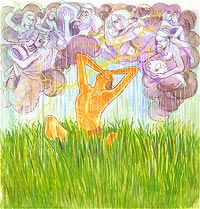
If some one is overcome by craving which is described as lowly and
poisonous, his sorrows grow as swiftly and profusely as birana grass,
after being exposed to repeated rains.

Craving is a lowly urge. It is difficult to escape craving. But, in
this world, if someone were to conquer craving, sorrow will slip off
from him like water off a lotus leaf.

All those here assembled, may you all be well. I will advise you
towards your well-being. The person who is keen to get sweet-smelling
usira roots must first dig up the birana grass roots. In the same way,
dig up the roots of craving. If you did that, Mara - death - will not
torture you over and over like a flood crushing reed.

Even when a tree has been cut down, it will grow up again if its roots
are strong and unharmed. Similarly, when traces of craving remain, the
suffering is likely to arise again and again.

If in a person the thirty-six streams flow strongly towards pleasurable
thoughts, that person of depraved views will be carried away on those
current of craving.

The streams of craving flow towards objects everywhere. As a result, a
creeper springs up and flourishes. The wise, when they see this creeper,
should cut its root with wisdom.

Craving arises in people like flowing streams. These flow towards
pleasure and sensual satisfaction. Such people who are bent on pleasure
will experience repeated cycles of birth and decay.

Surrounded by craving the masses tremble like a hare caught in a trap.
Shackled by ten fetter and seven sangas, men and women suffer again and
again over a long period of time.

Surrounded by craving the masses tremble like a hare caught in a trap.
Therefore, a monk desiring to attain detachment - Nibbana - should shun
craving.

Having left the forest of desire he takes to the forest of the practice
(i.e. the life of a monk); but when he is free from the forest of
desire he rushes back to that very forest. Come, look at that man who
having become free rushes back into that very bondage.
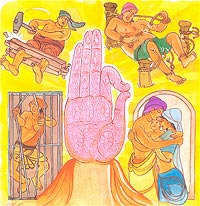
The yearning for sons and wives are a stronger attachment than all the
physical bonds made of iron, wood or hemp. Therefore, consider how to
deal with this basic desire with wisdom.

The wise agree that this is a strong bond. It tends to deprave. Though
this seems a lax knot, it is difficult to untie it to be free. However
difficult the process is, freeing themselves from yearning for sensual
pleasures, the wise leave household life and become ascetics.
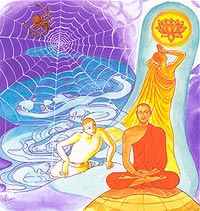
Beings who are infatuated with lust fall back into the stream of
craving they have generated, just as a spider does in the web it has
spun. The wise cutting off the bound of craving, walk on resolutely,
leaving all ills (dukkha) behind.

Give up the past, give up the future, give up the present. Having
reached the end of existence, with a mind free (of all conditioned
things), you will not again undergo birth and decay.

In those whose minds are agitated and assailed by doubts and
suspicions, whose passions and sensualities are sharpened, craving
increases more and more. This makes the bonds tighter.
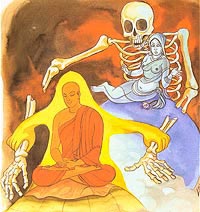
He who is constantly engaged in dispelling the doubts and suspicions
that assail the mind, is earnest and ever alert, looks on the world of
reality as not pleasant. He will eradicate craving and will cut off
bonds of death.
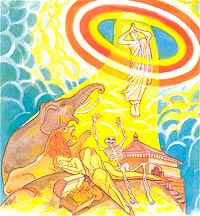
He has come to cessation. He has reached the goal of his monastic life.
He is free of fear, craving and is blemishless. He has broken the
thorns of existence. This is his final being.
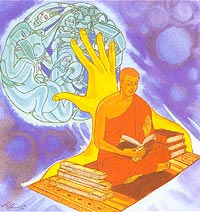
He is free of craving and devoid of grasping. He is well versed in
etymology and in usages. He is aware of characters and their deployment
into combinations. He knows the sequence of letters. He knows the old
dialect. This is his last body. That person is a great wise man.

I have overcome all, I know all, I am detached from all, I have given
up all; I am liberated from moral defilements having eradicated craving.
Having comprehended the four noble truths by myself, whom shall I point
out as my teacher.

The gift of Dhamma excels all others gifts; the taste of Dhamma excels
all other tastes; delight in the Dhamma excels all other delights. The
eradication of craving overcomes all ills.

Wealth destroys the foolish; but it cannot destroy those who seek the
other shore (i.e. Nibbana). By his craving for wealth the fool destroys
himself, as he would destroy others.

Fields have grasses as their bane. The ordinary masses have passion as
their bane. Therefore, high yields are possible only through what is
given to the passionless ones.
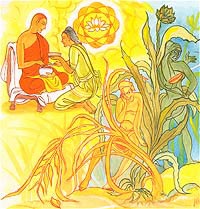
Fields have weeds as their bane. The ordinary masses have passion as
their bane. Therefore, high yields are possible only through what is
given to those without ill-will.
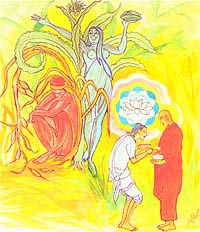
Fields have weeds as their bane. The ordinary masses have passion as
their bane. Therefore, high yields are possible only through what is
given to the one without illusion.

Fields have weeds as their bane. The ordinary masses have passion as
their bane. Therefore, high yields are possible only through what is
given to the one without desire.
|
How many languages are there in the world?
When
a just born baby is kept isolated without anyone communicating with the baby, after a few days it will speak and human natural (Prakrit) language known as Classical Magahi Magadhi/Classical Chandaso language/Magadhi Prakrit,Classical Hela Basa (Hela Language),Classical Pāḷi which are the same. Buddha spoke in Magadhi. All the 7,139 languages and dialects are off shoot of Classical Magahi Magadhi. Hence all of them are Classical in nature (Prakrit) of Human Beings, just like all other living speices have their own natural languages for communication. 117 languages are translated by https://translate.google.comin
15) Classical Basque- Euskal klasikoa,
16) Classical Belarusian-Класічная беларуская,
17) Classical Bengali-ক্লাসিক্যাল বাংলা,
18) Classical Bosnian-Klasični bosanski,
19) Classical Bulgaria- Класически българск,
|


